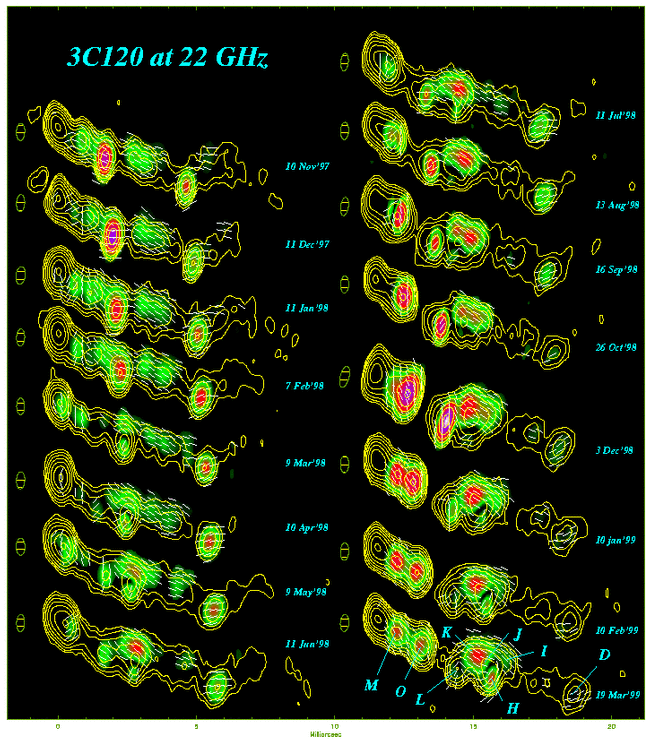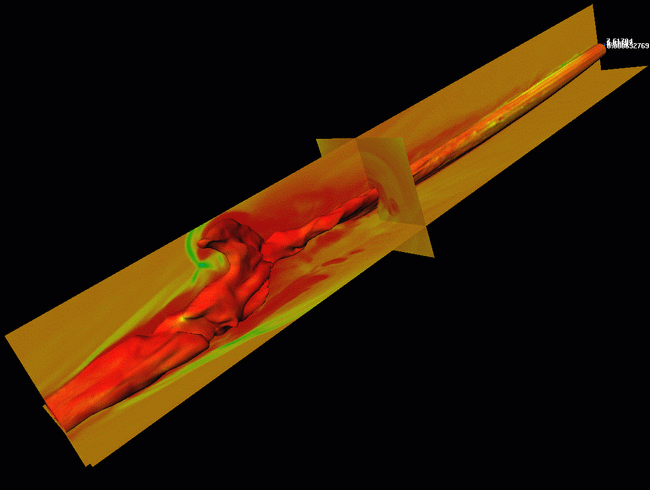Unveiling the secrets of the radio source 3C120 |
Simulations of a relativistic jet emerging from the powerful radio galaxy 3C120 are currently being performed at the Max-Planck-Institut für Astrophysik by Miguel A. Aloy and Ewald Müller.
Presently, there is much excitement in the high energy and relativistic astrophysics communities, as advanced detectors in all electromagnetic bands provide access to exotic objects such as jets, black holes and neutron stars. Undoubtedly, extragalactic jets are among the most exciting observational targets. In order to explain their enormous energy output extragalactic jets must be linked to very energetic astrophysical phenomena, like e.g., the ejection of relativistic plasma from the neighborhood of supermassive black holes existing in the centers of active galaxies. With VSOP, a soon to be deployed space-based radio-interferometer, one can obtain extremely well resolved radio maps of the innermost parts of a jet. The instrument will be able to resolve objects of the size of a soccer ball on the moon, or structures half a lightyear across in case of 3C120, which is located at a distance of 450 million lightyears. VSOP observations will shed some light on the unresolved problem of jet formation and collimation. However, obtaining a deeper theoretical understanding of such astrophysical phenomena also relies to a considerable extent on large scale computer simulations of the underlying physical processes. Such simulations are currently being carried out at the Max-Planck-Institut für Astrophysik by Miguel A. Aloy in collaboration with Jose M. Martì (University of Valencia, Spain), Jose L. Gòmez (Instituto de Astrofìsica de Andalucìa, Spain) and Ewald Müller.

|
| Figure 1: Time sequence of radio maps of the radio source 3C120 obtained by J.L. Gòmez and co-workers. |
From 1997 to 1999 the radio galaxy 3C120 has been the object of a detailed observational campaign by Jose L. Gòmez and co-workers using VLBA, a system of more than ten large radio antennas operated by the US National Radio Astronomy Observatory and scattered across the whole USA from Hawaii to the Virgin Islands. The observations have revealed the existence of a cloud of gas (about 25 lightyears away from the central black hole), which is apparently being struck by a jet with a velocity of about 98.6% of the speed of light. The collision heats up the jet material near the cloud causing a spatially extended emission maximum in the radio maps. The observations further show the jet as a set of emission maxima (components or blobs) whose intensity and position varies with time. In fact, the blobs seem to bolt away from the central black hole at velocities larger than the speed of light. Their superluminal motion is, however, only a projection effect. Actually, the blobs move at velocities very close, but always below the speed of light, almost exactly towards the observer.

|
| Figure 2: Snapshots from a hydrodynamic simulation of a relativistic jet by M.A. Aloy modelling the observed jet of the radio source 3C120. |
Trying to infer from the observations the actual path of the jet and the motion of its components in interstellar space is a challenging task. Firstly, we can only observe the projection of a possibly very complex path on the sky. Secondly, the effect of radiation beaming must be taken into account. Due to this relativistic effect we can only see those parts of the jet which are moving directly towards us. To disantangle the observations of 3C120 M.A. Aloy, J.M. Martì, J.L. Gòmez and E. Müller have performed relativistic hydrodynamic simulations in three spatial dimensions. In their model the jet describes a helical pattern around an axis, i.e. the jet is assumed to precess. The assumed motion is similar to that of a beam of water leaving a garden hose when one moves the end of the hose in a narrow circle. If that is indeed the actual jet path, we will see only those parts of the helix where the jet is moving towards us, while all other parts of the jet cannot be observed. The hydrodynamic simulations are still in progress. They will provide the flow data from which one can compute the radio emission of the model jet. Such synthetic radio maps provide an excellent tool to link radio observations and theoretical models, and to improve the latter.
| MPA-Home |